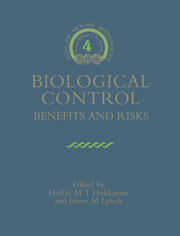Book contents
- Frontmatter
- Contents
- List of Contributors
- Series Preface
- Preface: Overview of Benefits and Risks of Biological Control Introductions
- Part I Biological Invasions
- Part II Classical Biocontrol
- Part III Augmentative Biocontrol
- 9 The Use of Exotic Organisms as Biopesticides: Some Issues
- 10 Use of Trichogramma in Maize – Estimating Environmental Risks
- 11 Entomopathogenic Nematodes in Biological Control: Feasibility, Perspectives and Possible Risks
- 12 Pseudomonads as Biocontrol Agents of Diseases Caused by Soil-borne Pathogens
- 13 Biological Control of Soil-borne Pathogens of Wheat: Benefits, Risks and Current Challenges
- 14 Genetically Engineered Fluorescent Pseudomonads for Improved Biocontrol of Plant Pathogens
- 15 Biological Control of Foliar Fungal Diseases
- 16 The Use of Fungi, Particularly Trichoderma spp. and Gliocladium spp., to Control Root Rot and Damping-off Diseases
- 17 Bacillus thuringiensis in Pest Control
- 18 Opportunities with Baculoviruses
- Part IV Use of Genetically Modified Organisms
- Part V Economics and Registration
- Index
17 - Bacillus thuringiensis in Pest Control
Published online by Cambridge University Press: 07 May 2010
- Frontmatter
- Contents
- List of Contributors
- Series Preface
- Preface: Overview of Benefits and Risks of Biological Control Introductions
- Part I Biological Invasions
- Part II Classical Biocontrol
- Part III Augmentative Biocontrol
- 9 The Use of Exotic Organisms as Biopesticides: Some Issues
- 10 Use of Trichogramma in Maize – Estimating Environmental Risks
- 11 Entomopathogenic Nematodes in Biological Control: Feasibility, Perspectives and Possible Risks
- 12 Pseudomonads as Biocontrol Agents of Diseases Caused by Soil-borne Pathogens
- 13 Biological Control of Soil-borne Pathogens of Wheat: Benefits, Risks and Current Challenges
- 14 Genetically Engineered Fluorescent Pseudomonads for Improved Biocontrol of Plant Pathogens
- 15 Biological Control of Foliar Fungal Diseases
- 16 The Use of Fungi, Particularly Trichoderma spp. and Gliocladium spp., to Control Root Rot and Damping-off Diseases
- 17 Bacillus thuringiensis in Pest Control
- 18 Opportunities with Baculoviruses
- Part IV Use of Genetically Modified Organisms
- Part V Economics and Registration
- Index
Summary
Introduction
The spore-forming, Gram-positive bacterium. Bacillus thuringiensis (Bt), is a ubiquitous soil micro-organism with a world-wide distribution (Martin and Travers, 1989). Many thousands of isolates have been discovered since Ishiwata first isolated Bt from diseased silkworm larvae in 1901 (Nakamura and Dulmage, 1988; Beegle and Yamamoto, 1992; Feitelson et al, 1992), and it is possible to group these isolates into at least 34 serovars (also called subspecies) (de Barjac and Fraction, 1990). However, biomolecular techniques, such as multiplex polymerase chain reaction (PCR), permit a more rapid identification of strains (Bourque et at., 1993), and it is now possible to target specific DNA sequences with the use of this technology.
The delta-endotoxin produced by Bt is the most widely used biological pesticide – 2.3 million kg was used annually according to Rowe and Margaritis (1987) – and it is the ‘front-runner’ in attempts to commercialize biological control agents (BCAs); albeit that Bt is only a BCA in a limited sense, since it is the product of a living organism (the delta-endotoxin) which is utilized, rather than the organism itself.
The precise ecological role of this cosmopolitan invertebrate pathogen in the natural environment remains speculative (Smith and Couche, 1991). Bt reportedly does not produce spores or crystals in infected host cadavers, it is relatively poor at spreading natural infections in the field and rarely causes epizootics (Fuxa, 1989). Its ubiquitous occurrence in the soil (Martin and Travers, 1989), phylloplane microflora (Smith and Couche, 1991), and in man-made ecosystems (Meadows et al., 1992) suggests that it may have a primary function other than as a pathogen.
- Type
- Chapter
- Information
- Biological ControlBenefits and Risks, pp. 190 - 200Publisher: Cambridge University PressPrint publication year: 1995
- 9
- Cited by



